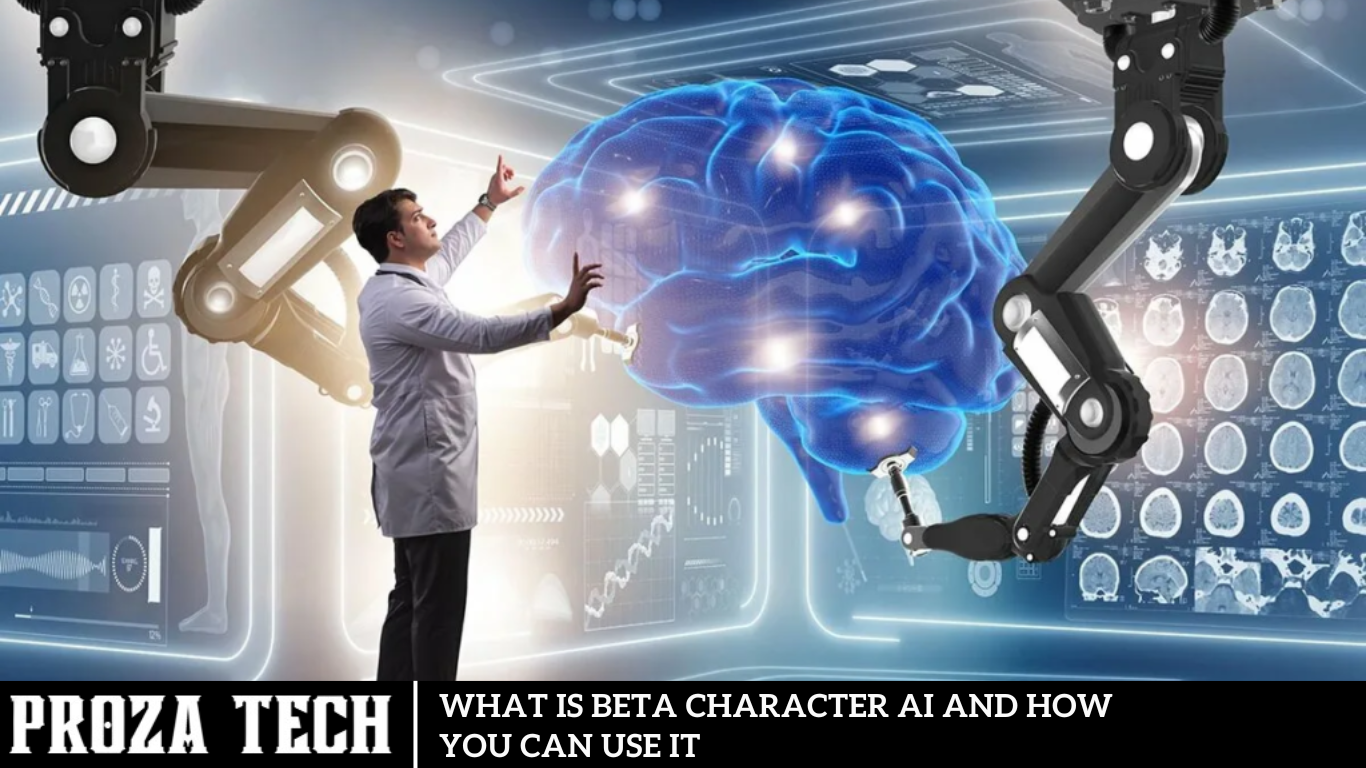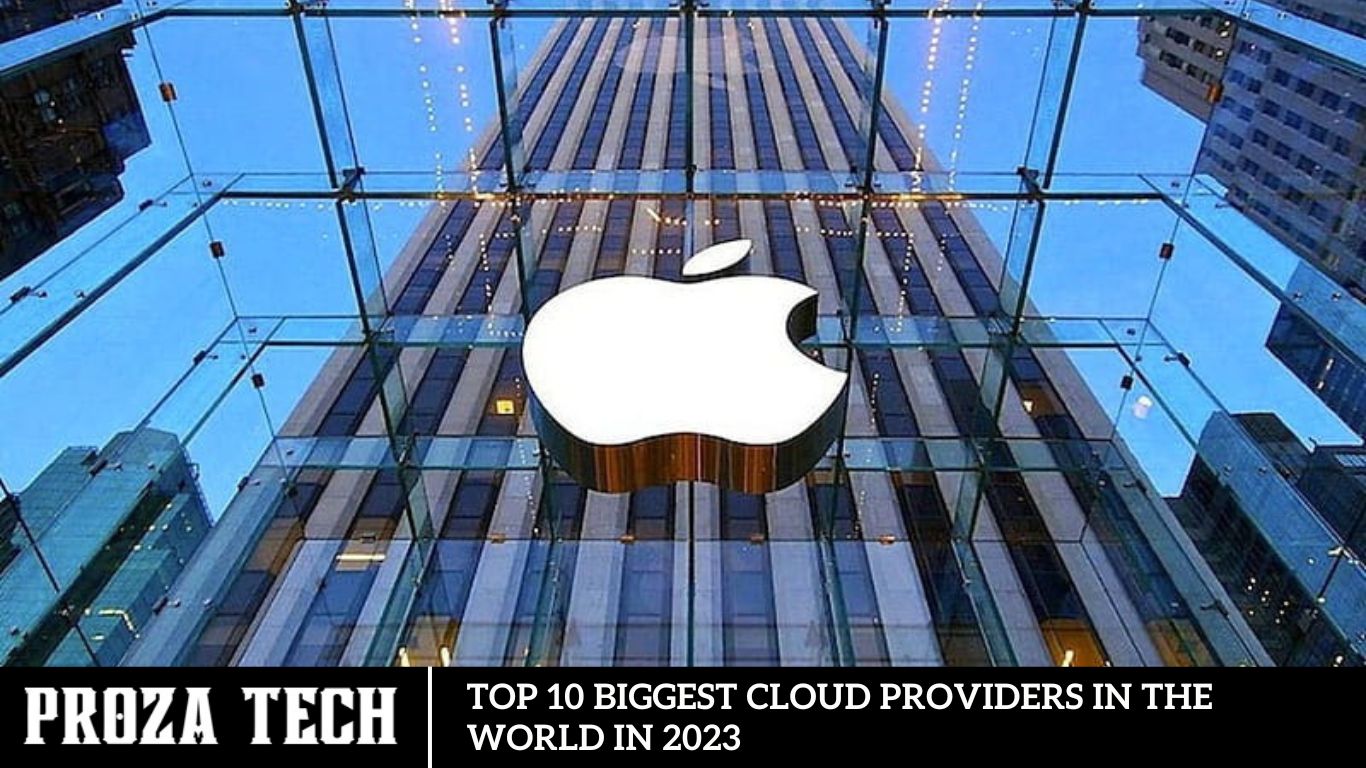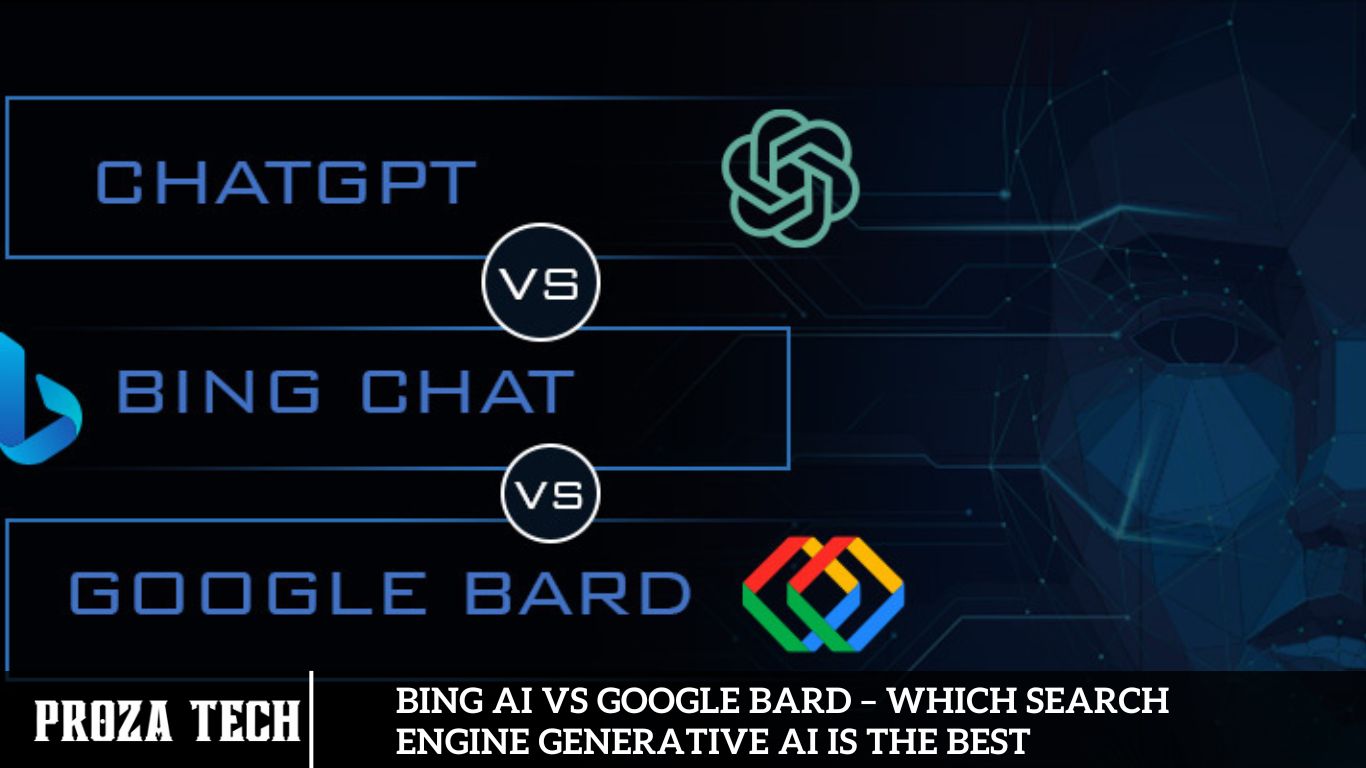Technology
What Is Beta Character Ai And How You Can Use It

Beta Character AI is a chatbot designed to communicate in the manner of specific existing or imaginative personalities. The chatbots in Beta Character AI possess developed personality traits and use the vocabulary characteristic of the Character or person they represent.
What Is Character AI?
Character AI is an innovative platform for creating characters. Powered by advanced AI technology, it processes vast amounts of text to provide intelligent and contextually relevant responses. Whether you want to develop fictional characters or ones based on real people, living or deceased, Character AI offers a unique and enjoyable experience.
Is Character AI Free?
Character AI is entirely free to use, but for those seeking additional features, there’s c.ai+! This premium version offers exclusive benefits such as priority access to chats, faster response times from characters, and early access to new features before they’re released to the public.
Understanding How Beta Character AI Functions
Beta Character AI was launched in 2022 by co-founders Noam Shazeer and Daniel De Freitas, the minds behind Google’s LaMDA (Language Model for Dialogue Applications). As they explained to the Washington Post, the goal of Beta Character AI was to offer companionship to lonely individuals during the COVID-19 pandemic.
The platform allows users to engage in dialogues with well-known figures like Elon Musk, Donald Trump, or Volodymyr Zelenskyy. It can also personify fictional characters from renowned literary works or even embody the authors themselves. Users can converse with characters like Sherlock Holmes or Harry Potter or with authors such as C.S. Lewis, George R.R. Martin, or Vergil.
The program also enables users to create personalized characters for future interactions. Users can choose whether their characters are visible to others and if other users can engage them. The platform also offers an online community for sharing ideas and collaborating with other users.
Key Features of Beta Character AI
The Character Book provides instructions on how to use the program. Users are cautioned that all information is fabricated, and the chatbots may give misleading information. As the program continually improves, characters could generate harassing or insulting text or offer links to nonexistent information.
Despite these issues, chatbots can be beneficial in several ways. Some chatbots are not designed to mimic personalities or well-known figures but are created to help users generate ideas (e.g., Brainstormer) or offer book recommendations (e.g., Librarian Linda).
The platform includes a speech-to-text option for inputting prompts to the chatbot. However, chatbots only respond via text, as text-to-speech support is still developing.
The program is free to use, but there is also a paid version, c.ai+, which provides:
- Faster responses.
- Uninterrupted service during peak usage times.
- Early access to new features.
The platform’s creators assure users that the system is safe, as private conversations with AI-created characters are not accessible or readable by third parties.
Beta Character AI: What is IT?
Undoubtedly, AI has become incredibly popular for answering questions and generating images. Thanks to its impressive features, AI has quickly gained widespread popularity. Beta Character AI stands out among the various AI technologies, allowing users to create and interact with their own AI characters from any genre or setting.
Beta Character AI enables users to create personalized AI characters and engage in open-ended conversations with them. This application is an excellent choice for those seeking companionship or someone to talk to. Powered by neural language models, Beta Character AI can generate realistic and natural dialogues based on extensive text data.
Beta Character AI is an excellent option if you’re looking for a fun and innovative way to explore conversational AI. Today, we will delve into what Beta Character AI is, how it works, its advantages, the challenges users might face, and much more. Stay tuned for a comprehensive overview.
An Overview of Beta Character AI
Character AI Beta is an AI (artificial intelligence) chatbot that uses a neural language model to generate text responses. It allows users to create and engage in conversations with their characters. Unlike other AI chatbots like ChatGPT, Beta Character AI produces more human-like interactions and supports chatting with multiple bots simultaneously.
Since its release in September 2022, Beta Character AI has quickly become popular among users. Consequently, many enterprises seek AI development companies that can deliver high-quality solutions without compromising standards.
How Does the Beta Character AI Work?
One of the exciting aspects of Beta Character AI is its backing by OpenAI. This application primarily generates new texts by analyzing input word order. With billions of parameters, reinforcement learning, and a transformer design, it can swiftly adapt to context.
In marketing, users can utilize Beta Character AI to compose various text types, such as articles, blogs, and research papers, leveraging its ability to reflect contemporary realities. However, its predecessor, GPT-2, limited its capabilities. Nevertheless, chatbots remain highly favored among users for engaging in conversations under fictional personas.
As mentioned earlier, Beta Character AI is powered by a neural language model that learns from extensive text data, forming the bedrock of its functionality. This application employs its proprietary technology, specifically developed and trained for dialogue.
The neural language model relies on the information about the Character, encompassing details like their name, personality, description, genre, and history. Consequently, Beta Character AI’s popularity continues to soar among users.
Advantages of Beta Character AI
The popularity of Beta Character AI for creating personalized AI characters is undeniable. However, there are several other significant advantages to using Beta Character AI. Below, we outline some of these benefits:
Early User Feedback
One of Beta Character AI’s primary advantages is its capability to gather valuable user feedback before the entire product launch. This feedback plays a crucial role in identifying glitches, bugs, and user experience issues that may have gone unnoticed during internal testing. Additionally, early users provide insights into real-world usage scenarios, enabling developers to make necessary adjustments.
To leverage this significant advantage, one can opt to build an app. However, this entails finding a software development company with a team of professionals to complete the project within the committed timeframe.
Bug Identification and Testing
Another benefit of this application is its ability to facilitate widespread testing across various environments and user behaviors. This encompasses discovering unforeseen issues, bugs, edge cases, and compatibility challenges that might not have been evident in controlled testing settings. The AI product can offer users a smoother experience by addressing these issues before the official release.
This is a significant advantage of Beta Character AI. Additionally, individuals can explore the option of developing their own AI app by enlisting the assistance of a mobile app development company. These companies can provide comprehensive solutions with their years of experience and appropriate skill sets.
Feature refinement
During the development phase, the basic functionality of an AI may be well-defined. However, beta testing often reveals opportunities for improvement and refinement. Users can suggest new use cases or enhancements that developers may not have considered, resulting in a more flexible and powerful AI system.
Improved User Experience
Involving real users in testing enables developers to better understand how people interact with AI in real-world scenarios. This insight helps streamline the user experience, optimize workflows, and eliminate confusing or redundant elements that could impact overall user satisfaction.
Stress Testing
Real-world usage can impose greater demands on an AI system than controlled test environments. Beta Character AI undergoes stress testing to evaluate its performance under various loads and usage patterns. This helps identify performance and scalability bottlenecks, ensuring the AI can efficiently handle large user volumes.
Risk Reduction
Releasing AI in beta allows developers to mitigate risks associated with a full launch. If critical issues arise during beta testing, adjustments can be made to the official product launch. This proactive approach minimizes the potential for significant setbacks and reputational damage to the AI.
Community Building
The beta phase presents an opportunity to cultivate a community of early adopters invested in the AI’s success. These users often contribute to forums, discussion groups, and social conversations, generating anticipation and excitement about the AI’s eventual launch.
Iterative Development
Beta AI characters are part of an iterative development process. Developers can release new beta versions to gather additional insights as developers incorporate user feedback and testing results. This iterative approach leads to a more refined and feature-rich end product.
The Technology Behind Beta Character AI
At the core of Beta Character AI lies sophisticated algorithms, machine learning models, and natural language processing techniques. These elements work in tandem to analyze vast datasets of human interactions, enabling AI systems to mimic human behavior with remarkable accuracy. Additionally, reinforcement learning is crucial in refining these AI entities, allowing them to adapt and improve over time.
Applications of Beta Character AI
- Customer Service and Support: Beta Character AI can enhance customer service experiences by providing personalized assistance and resolving inquiries conversationally.
- Virtual Assistants: Beta Character AI-powered virtual assistants offer seamless support across various tasks, from scheduling appointments to answering queries.
- Education and Training: Beta Character AI can serve as interactive tutors, guiding learners through personalized learning journeys and providing real-time feedback.
- Entertainment and Gaming: In entertainment, Beta Character AI brings characters to life, creating immersive gaming experiences and interactive storytelling.
Features of Beta Character AI
In any application, features are crucial, and Beta Character AI stands out with its impressive capabilities that enhance its popularity among users. This cutting-edge AI entity offers advanced features that push the boundaries of what AI can achieve. Here are the key features that make Beta Character AI exceptional:
Key Features of Beta Character AI
Natural Language Understanding (NLU)
At the core of Beta Character AI is an advanced NLU system, enabling it to understand and process human language with remarkable accuracy. It interprets context, nuance, and colloquial expressions, providing meaningful and contextual responses.
Contextual Memory
Beta Character AI has a contextual memory that allows it to recall past interactions, maintaining conversation continuity. This feature enables more personalized and consistent dialogues over time, simulating the continuity found in human interactions.
Emotional Intelligence
A standout feature of Beta Character AI is its ability to understand and react to emotions. Through sentiment analysis and tone recognition, it assesses a user’s emotional state and adjusts its responses accordingly, demonstrating empathy and understanding.
Personalization
Beta Character AI customizes its responses based on user preferences and historical interactions. This level of personalization enhances user engagement and creates a more natural and relevant AI experience.
Multimodal Interaction
Beyond text, Beta Character AI integrates seamlessly with various communication methods, including voice, images, and even gestures. This facilitates a more dynamic and comprehensive interactive experience.
Active Learning
The AI’s learning ability is dynamic and ongoing. It continuously adapts and evolves based on new information and user interactions, making it an ever-improving conversational partner.
Extensive Knowledge Base
With access to a vast knowledge base, Beta Character AI can provide information and answer questions on various topics. Its responses are based on up-to-date and reliable sources.
Creativity and Problem Solving
In addition to providing information, Beta Character AI engages in creative thinking and problem-solving. Based on the information provided, it can generate ideas, propose solutions, and simulate different outcomes.
Benefits and Limitations of Using Character.AI
This section will explore the benefits and limitations of using Character. AI.
Advantages of Character.AI
Character AI provides a host of unique benefits. It enables users to interact with various characters, offering diverse perspectives. Whether you want to chat with Elon Musk, Edward Cullen from Twilight, or Taylor Swift, the experience feels remarkably real, unlike other chatbots.
This advanced AI allows you to create characters with distinct personalities and avatars. The process is straightforward, and the platform is accessible via Android and iOS apps, making it convenient to use on your phone.
One of the standout features of Character AI is its wide range of themes. The platform offers nearly twenty options to explore, from helpers and games to image creation, movie and TV actors, and language learning.
Drawbacks of Character.AI
Character AI is an impressive example of artificial intelligence but has limitations. The characters are user-generated, sometimes producing inaccurate information, known as hallucinations. It’s important to remember that these interactions are fictional, and most of what the characters say is fabricated.
Additionally, Character AI is primarily designed for generating text, not images, so it can’t create visuals like other AI art generators. It also strictly blocks inappropriate content (NSFW), which can be beneficial depending on your needs. Moreover, Character AI doesn’t offer an API, so you can’t download it to create your version on your computer.
Frequently Asked Questions
What is Beta Character AI?
Beta Character AI, often abbreviated as β-character AI, is an advanced artificial intelligence designed to imbue digital entities with human-like characteristics and behaviors. Unlike traditional AI systems focused solely on task completion, Beta Character AI incorporates emotions, personality traits, and natural language understanding to facilitate more engaging and interactive interactions.
How does Beta Character AI work?
Beta Character AI operates on sophisticated algorithms, machine learning models, and natural language processing techniques. These components analyze vast datasets of human interactions to mimic human behavior accurately. Additionally, reinforcement learning enables Beta Character AI entities to adapt and improve over time, enhancing their conversational capabilities and overall performance.
What does the future hold for Beta Character AI?
As technology evolves, the potential of Beta Character AI is limitless. Researchers and developers continually push the boundaries, leading to even more sophisticated and lifelike digital entities. In the future, we expect Beta Character AI to play a significant role in advancing human-computer interaction and revolutionizing various industries.
Conclusion
Beta Character AI represents a groundbreaking advancement in AI technology, offering unprecedented opportunities for human-computer interaction. Businesses and individuals can leverage Beta Character AI to enhance their operations and experiences by understanding its capabilities, applications, and implementation strategies. Embrace the future of AI and unlock the full potential of Beta Character AI today.
Technology
Top 10: Biggest innovations of 2023

From Breakthroughs in Quantum Computing to Advances in AI: Technology Magazine’s Top 10 Technology Innovations of 2023
In 2023, the technological landscape experienced dramatic changes driven by groundbreaking innovations. This year saw significant advancements across various fields, pushing the boundaries of what was previously thought possible. Technology Magazine highlights ten of the most influential innovations that have shaped the past year.
Quantum computing is leading the charge, with breakthroughs that promise to revolutionize industries by solving complex problems at unprecedented speeds. Quantum computers are now closer than ever to becoming practical tools for scientific research and advanced data analysis.
Artificial intelligence has also seen remarkable progress, particularly in the realm of large language models. These AI systems have become more sophisticated, enabling more natural and nuanced human-computer interactions. Generative AI, in particular, has shown its potential by creating everything from realistic text and images to intricate designs and music compositions.
The field of robotics has stayed strong, with advanced robotics solutions enhancing automation in manufacturing, healthcare, and service industries. These robots are becoming more autonomous and capable, improving efficiency and safety in various applications.
Additionally, innovations in renewable energy technologies pave the way for a more sustainable future. Advances in solar and wind energy, energy storage solutions, and intelligent grid technology contribute to a significant shift towards greener energy sources.
In the healthcare sector, biotechnological advancements are making headlines with breakthroughs in gene editing, personalized medicine, and advanced diagnostic tools. These innovations promise better treatments and improved patient outcomes.
Furthermore, the rise of the Internet of Things (IoT) continues to connect devices and systems in ways that enhance convenience and efficiency in everyday life. Smart homes, cities, and industries are becoming more common as IoT technology evolves.
These ten innovations represent just a glimpse of the technological progress made in 2023. As these advancements develop, they will undoubtedly shape the future in profound and exciting ways.
Simplifying Multicloud Management
In 2023, cloud technology witnessed remarkable innovations, especially in addressing the complexities of multi-cloud environments.
SAS research indicates that organizations now typically operate across three private clouds, with nearly half (42%) also utilizing at least two public cloud providers for business applications, analytics, and critical data hosting.
At its Explore 2023 event in Barcelona, VMware announced its efforts to help organizations adopt a ‘Cloud Smart’ strategy, transforming multi-cloud complexity into a competitive edge.
Cutting-Edge Robotics
Robotics technology has seen significant advancements, with applications spanning from industrial automation to personal robots.
Earlier this year, Amazon announced the commencement of testing for Digit, a bipedal robot capable of grasping and lifting items, developed in collaboration with Agility Robotics. Amazon stated that the initial use for this device would be to move empty tote boxes, a task described as ‘highly repetitive.’’ Since integrating robotics into its facilities in 2012, Amazon claims to have created hundreds of thousands of jobs globally.
Quantum Computing: Redefining Computational Power
Quantum computing emerged as a frontrunner in technological innovation in 2023. Companies such as Google, IBM, and others made significant breakthroughs, achieving milestones in quantum supremacy and solving complex problems at unprecedented speeds. Quantum computers promise to revolutionize fields like cryptography, drug discovery, and weather forecasting, ushering in a new era of computational power.
Web3 and Blockchain Innovations
Blockchain technology has advanced far beyond cryptocurrencies, bringing innovations in decentralized finance (DeFi) that open up new opportunities for investment and financial transactions. These advancements are disrupting traditional financial systems by providing more secure and transparent ways to conduct business.
According to McKinsey & Company, while Web3 has challenges and risks, this technology has the potential for transformative effects.
Hyperautomation: Revolutionizing Workflow Efficiency
Coined by Gartner in 2020, hyper-automation represents a systematic, business-driven approach organizations employ to swiftly identify, assess, and automate various business and IT processes. According to UiPath, a leading RPA software company, hyper-automation integrates multiple facets of process automation, harnessing tools and technologies to enhance the capacity for automating tasks.
Boris Krumrey, Global VP of Automation Innovations at UiPath, emphasized to Technology Magazine that AI-powered automation elevates this technology to unprecedented levels. “The emergence of generative AI presents an exciting advancement in automation, where generative AI and automation synergize to unlock transformative advantages for businesses.”
Advancements in Quantum Computing
This year marked substantial progress in quantum computing.
During its annual Quantum Summit, IBM introduced its latest ‘Heron’ processor, featuring an architecture designed to achieve IBM’s highest performance metrics and lowest error rates among all IBM Quantum processors to date.
Furthermore, IBM unveiled the IBM Quantum System Two, its inaugural modular quantum computer and a pivotal component of IBM’s quantum-focused supercomputing framework. Located in Yorktown Heights, New York, this system has commenced operations with three IBM Heron processors and associated control electronics.
Next-Generation Connectivity: Beyond 5G
The deployment of 5G networks has surged in 2023, delivering unprecedented speeds and connectivity. Companies like Nokia and T-Mobile are leveraging their full potential. Meanwhile, research into 6G—the next generation of networks—has commenced, promising even more revolutionary advancements in wireless technology.
The advent of 6G networks is poised to redefine industries, economies, and society at large, from enhancing the Internet of Things ecosystem to enabling seamless integration of AI and immersive technologies.
According to a 5G Infrastructure Association report, 6G will usher in “near-instant and unrestricted complete wireless connectivity,” fundamentally transforming enterprise operations.
CRISPR Technology: Precision in Gene Editing
CRISPR technology continued evolving in 2023, with advancements that enhanced its precision and efficacy in gene editing. Scientists achieved notable progress in treating genetic disorders, developing disease-resistant crops, and exploring potential therapies for cancer and inherited diseases. The ethical implications and regulatory challenges surrounding CRISPR also gained prominence as its applications expanded.
Innovative Green and Sustainable Technologies
The rapid expansion of AI, cloud computing, and related technologies is driving the need for increased data center capacity. According to The World Economic Forum’s ‘Top 10 Emerging Technologies of 2023’ report, several emerging technologies focus on achieving net-zero-energy data centers. Innovations include using water or dielectric liquid cooling systems to manage heat dissipation.
AI-driven systems also play a crucial role by analyzing and optimizing energy usage in real time, significantly improving efficiency and performance. For instance, Google’s data centers have achieved up to a 40% reduction in energy consumption through these advancements.
Zero Trust Security Model
The concept of Zero-Trust Security, characterized by a ‘never trust, always verify‘ approach, gained recognition in 2023 as a fresh and effective solution to the challenges posed by hybrid and remote working environments.
According to a Cisco report, nine organizations globally have begun adopting zero-trust security measures. In an interview with Technology Magazine, John Roese, the Global CTO of Dell Technologies, anticipates that this trend will continue, with companies increasingly viewing Zero-Trust as standard practice by 2024.
“Zero Trust will become the default endpoint toward which organizations are progressing,“ he stated. “It represents the correct approach to fundamentally altering the cybersecurity landscape.”
Augmented and Virtual Reality
Augmented and virtual reality technologies are poised to dissolve the boundaries between the physical and digital realms, opening up novel avenues for interaction and education.
The debut of Apple’s Vision Pro headset, a highly anticipated entry into this field, was hailed by CEO Tim Cook as heralding “the dawn of a new computing era,“ with the product set to revolutionize spatial computing.
Apple’s headset could potentially accelerate the expansion of the metaverse, which a Bloomberg report projected will grow to US$615 billion by 2030.
2023: The Year Dominated by Generative AI
Undoubtedly, AI technologies were the highlight of 2023, continuing to advance significantly in natural language processing, deep learning, and AI ethics.
OpenAI’s multimodal GPT-4 model has demonstrated extraordinary capabilities in generating human-like text, marking a new era in human-computer interaction. Meanwhile, the latest iteration of its image creation tool, DALL-E 3, excels in producing more realistic images than ever before.
In December 2023, Google introduced Gemini, a model capable of mastering human-like conversations, understanding various forms of content, including images and code, and empowering developers to create new AI applications and APIs.
For more insights into the world of technology, check out the latest edition of Technology Magazine and follow us on LinkedIn and Twitter. You can also explore other magazines of interest, such as AI Magazine, Cyber Magazine, and Data Centre Magazine.
Take advantage of our upcoming Sustainability LIVE Net Zero event on March 6 and 7, 2024.
Space Tourism: Making the Final Frontier Accessible
Space tourism took a giant leap forward in 2023, with companies like SpaceX and Blue Origin making significant strides in making space travel more accessible. Successful launches, improved reusable rocket technology, and ambitious plans to colonize Mars captured global attention. As space tourism becomes a reality, its impact on the aerospace industry and tourism sector and our understanding of space exploration continues to grow.
Top 10: Innovations of 2023
In 2023, AI Magazine highlighted numerous groundbreaking AI innovations, showcasing the advancements made by various companies in artificial intelligence.
The year has been notably active for enterprises developing, deploying, and leveraging AI technologies. From forging new alliances to pioneering leadership changes, the sector has witnessed significant transformations quickly. Moreover, global leaders have increasingly engaged in discussions to foster safer AI development in collaboration with technology firms.
Here are some of the standout AI innovations of 2023, listed in descending order by their launch dates:
Gemini AI (Google, December 2023):
Gemini represents Google’s latest AI model, heralded as one of the most advanced systems. It excels in multimodal reasoning and comprehends complex textual and visual information, driving advancements in data analytics and AI app development.
DALL-E 3 (OpenAI):
DALL-E 3 is OpenAI’s latest iteration of its text-to-image model, enhancing image fidelity and detail accuracy. It enables users to generate tailored visuals from textual prompts, refining outputs with minimal adjustments.
Adobe Firefly 2 (Adobe):
Built on Adobe’s Sensei platform, Firefly 2 enhances creative workflows by offering generative AI tools tailored to diverse creative needs. It integrates seamlessly into Adobe applications, facilitating the realization of innovative ideas.
Duet AI (Google Cloud):
Duet AI is an AI assistant within Google Cloud that enhances productivity through natural language interactions. It guides cloud-related inquiries and best practices, supporting users while ensuring data control.
Llama 2 (Meta):
Meta’s Llama 2 is an open-source AI model focused on responsible AI use and proficiency across various benchmarks. It offers enhanced performance and extensive training on diverse datasets, contributing to AI safety and effectiveness.
IBM Watson (IBM, December 2023):
Watsonx.ai by IBM is a suite of tools integrating generative AI capabilities to empower businesses. It includes AI assistants and governance features to scale AI impact and ensure transparent machine learning workflows.
Bard (Google):
Bard is Google’s experimental conversational AI tool. It leverages large-scale language models to provide high-quality responses and support creative explorations in knowledge dissemination.
GPT-4 (OpenAI):
Released in 2023, GPT-4 builds upon OpenAI’s ChatGPT model, demonstrating superior performance in various professional and academic applications. It signifies significant advancements in natural language processing and deep learning capabilities.
Claude 2 (Anthropic):
Claude 2 is a versatile AI assistant designed for individual and enterprise tasks. It is characterized by enhanced performance and accessibility through APIs and a user-friendly interface.
Microsoft Copilot (Microsoft, early 2023):
Microsoft Copilot embodies an ‘AI-as-copilot‘ approach, integrating web intelligence and user data to enhance business efficiency and user experience across Microsoft platforms.
These innovations highlight AI’s transformative impact across diverse sectors, driving advancements in efficiency, creativity, and user interaction. For further insights into the evolving landscape of technology, explore the latest edition of Technology Magazine and stay updated with us on LinkedIn and Twitter. Additionally, attend our upcoming Sustainability LIVE Net Zero event on March 6 and 7, 2024.
The Best Inventions of 2023
Every year, TIME magazine showcases its selection of the year’s most innovative inventions. TIME for Kids has highlighted ten inventions, each offering unique solutions, enhancing convenience, or adding fun to everyday life. Which one stands out as your favorite?
Cooler Color
Traditional white paint reflects 80 to 90% of sunlight, but a new Whiter Paint reflects up to 98%, potentially reducing air-conditioning usage by 40%. Developed by a team at Purdue University, this paint helps keep cities more relaxed by reflecting heat into space.
Virtual Animals
At the Hologram Zoo in Brisbane, Australia, visitors encounter lifelike holographic animals like polar bears and whales in action. This innovative approach allows people to experience wildlife without keeping animals in captivity.
A Drive to Fly
Alef Aeronautics’ Model A is an all-electric, two-seat vehicle that doubles as a flying car. Approved for test flights by the Federal Aviation Administration, it aims to deliver its first model by 2026, blending the functionalities of a car and an aircraft.
The Language of Song
Duolingo’s music feature on its app enables users to learn music through interactive piano lessons, covering a wide range of musical pieces, from nursery rhymes to symphonies. This tool aims to make music education accessible and enjoyable for everyone.
Playing with Braille
Lego Braille Bricks teach tactile skills to visually impaired children by incorporating braille letters, numbers, and symbols into classic Lego bricks. These bricks are designed for inclusive learning and can be used alongside other Lego sets.
Easy Walking
Moonwalkers by Shift Robotics are battery-powered shoes with wheels that enhance walking speed and efficiency. Using AI, these shoes adjust to the user’s pace and lock the wheels when navigating stairs, enabling faster and less tiring walks.
For Starry Nights
LeapFrog’s Magic Adventures Telescope allows budding astronomers to explore the night sky with an attached zoom camera for taking pictures and educational games that teach about the solar system and beyond.
Stopping Fires
AlertCalifornia uses AI to predict wildfires in collaboration with the California Department of Forestry and Fire Protection. This system, equipped with over a thousand cameras, detects smoke and alerts local fire departments early, preventing potential disasters.
Clean Water
Lifestraw Max provides a solution for clean drinking water in conflict zones and disaster areas by removing bacteria, parasites, and viruses from water sources. It purifies up to 40 gallons of water per hour, aiding needy communities.
Air on Mars
NASA’s Moxie, attached to the Mars Perseverance rover, extracts oxygen from the Martian atmosphere. This could potentially provide future astronauts with breathable air and rocket fuel for return journeys.
These inventions represent cutting-edge solutions across various fields, from environmental sustainability to education and space exploration. Which innovation do you find most intriguing or impactful?
Frequently Asked Questions
What are the most significant innovations of 2023?
In 2023, several groundbreaking innovations emerged across various fields, including artificial intelligence (AI), quantum computing, biotechnology, sustainable energy, augmented reality (AR), blockchain, autonomous vehicles, space exploration, 5G connectivity, and robotics.
How did artificial intelligence (AI) revolutionize healthcare in 2023?
AI has made significant strides in healthcare by improving diagnostics accuracy, enabling personalized treatment plans, and enhancing robotic surgeries. These advancements have the potential to revolutionize patient care and medical outcomes.
What were the critical breakthroughs in quantum computing in 2023?
In 2023, quantum supremacy was achieved in various computational tasks, paving the way for faster processing speeds and enhanced data security. Quantum computing holds promise for solving complex problems beyond classical computers’ capabilities.
What advancements were made in biotechnology and genetic engineering?
CRISPR technology continued to evolve, allowing for precise gene editing and the development of personalized therapies. Biotech innovations also extended to sustainable agriculture practices, promoting healthier crops and reducing environmental impact.
How did sustainable energy solutions progress in 2023?
Renewable energy technologies saw significant advancements in 2023, with improvements in solar efficiency, energy storage systems, and the integration of renewables into the grid. These innovations aim to accelerate the transition towards a more sustainable energy future.
What applications did augmented reality (AR) have in 2023?
AR expanded beyond entertainment into various sectors, including remote work, education, healthcare, and retail. By overlaying digital information onto the real world, it offered immersive experiences and enhanced productivity.
Conclusion
The innovations of 2023 have set the stage for a future defined by technological advancements that push the boundaries of what is possible. From quantum computing to biodegradable plastics, each innovation addresses current challenges and opens new opportunities for growth and progress. As we look ahead, these breakthroughs will continue to shape industries, transform societies, and pave the way for a more interconnected and sustainable world.
Technology
Top 10 Technologies For The Classroom

The integration of technology in education is revolutionizing the classroom experience. With over 80% of the population owning smart devices, the reliance on technology in daily life has grown significantly. Consequently, educational institutions adopt innovative solutions to engage students and enhance learning outcomes. Here, we explore ten cutting-edge technologies that are transforming the academic landscape.
- Interactive Whiteboards: These boards replace traditional chalkboards, enabling dynamic and engaging lessons through digital interaction.
- Virtual Reality (VR): VR allows students to explore immersive environments, bringing subjects like history and science to life.
- Augmented Reality (AR): AR overlays digital information onto the physical world, providing interactive and context-rich learning experiences.
- Artificial Intelligence (AI): AI personalizes learning by adapting content to individual students’ needs and providing real-time feedback.
- Online Learning Platforms: Coursera and Khan Academy offer a vast range of courses, making education accessible anytime, anywhere.
- Gamification: Integrating game elements into education motivates students and makes learning more engaging.
- 3D Printing: This technology enables hands-on learning, allowing students to create tangible models and prototypes.
- Robotics: Robotics education fosters critical thinking and problem-solving skills through interactive and practical applications.
- Cloud Computing: Cloud-based tools facilitate collaboration, storage, and access to resources from any location.
- Internet of Things (IoT): IoT devices in the classroom, such as smart boards and connected lab equipment, streamline administrative tasks and enhance interactive learning.
These advancements make learning more interactive and enjoyable and prepare students for a future driven by technology. As classrooms continue to evolve, these technologies will play a crucial role in shaping the educational experiences of tomorrow.
Immersive Virtual Reality
Virtual reality is revolutionizing every aspect of education. VR offers an immersive experience that closely mimics real life by creating an artificial environment viewed through a headset. This technology enables students to explore different parts of the world from their classrooms. Additionally, virtual museum tours provide invaluable resources for students studying art, science, and history, enhancing their learning experience dynamically and engagingly.
Digital Tablets
Digital tablets, whether plug-in or wireless, provide students and artists with the tools to create digital drawings and designs. These devices facilitate learning in the growing field of digital design. By eliminating the need for paper, digital tablets help reduce waste, offering unlimited digital paper and materials. Popular devices include the iPad Pro with Apple Pencil, Wacom Intuos, and Huion H420.
Game-Based Learning
Over 90% of children in the United States regularly play video games, so integrating gaming into the classroom engages students more effectively than traditional teaching methods. Game-based learning enhances curriculum delivery and improves memory and hand-eye coordination. Teaching students to create and code games imparts valuable skills, preparing them for future careers in the expanding gaming industry.
Gamification integrates game elements such as rewards, competition, and storytelling into educational content. By turning lessons into interactive challenges, educators can motivate students, promote problem-solving skills, and create a conducive learning atmosphere that encourages persistence and collaboration.
3D Printing
3D printing is a pivotal technology in education, particularly for design-based courses. Architecture, materials science, and engineering students can use 3D printing to create prototypes and models. Additionally, science students can print molecular structures and models for study, enhancing their understanding of complex concepts.
Ozobot Robots
Ozobot offers products designed to teach young children coding basics through interactive play. The Ozobot Evo robot, usable with a tablet app or paper and markers, sparks interest in coding and lays a foundation for future technological skills.
3D printing enables hands-on learning experiences by allowing students to design and create physical objects. It promotes creativity, problem-solving skills, and a deeper understanding of spatial relationships, from prototyping models in STEM subjects to visualizing complex concepts in the arts and sciences.
Tablets
Tablets, now integral to daily life and work, are being increasingly adopted in education. They replace notebooks and textbooks, allowing students to store all their work on one device and helping schools reduce paper use. Tablets engage students more effectively and are more user-friendly than computer rooms or laptop trolleys. Popular classroom brands include the iPad Mini, Amazon Fire Tablet, and Samsung Galaxy Tab.
Smartboards
Smartboards are large, interactive projector screens that display an upscaled computer screen version. They can be drawn on and controlled directly, enhancing classroom interactivity. Unlike traditional whiteboards, smartboards do not require real pens or frequent cleaning.
E-Books
E-books, available as apps for digital devices or as dedicated e-readers, offer a digital alternative to traditional books. They are often cheaper and can store multiple titles on one device, making them ideal for education. E-books reduce waste by eliminating the need for physical books that become outdated or damaged.
Document Cameras
Document cameras project paper documents onto projectors and smartboards, allowing teachers to display images and objects to the class. Commonly used in science classes, they enable students to view experiments without crowding around a single area.
Remote Learning
The global pandemic accelerated the adoption of remote learning. Video conferencing platforms like Zoom, Teams, and Google Meet became essential tools, allowing education to continue uninterrupted. This technological shift ensured that students could maintain their studies even during lockdowns.
Top 8 classroom technology tools
During an extended period of remote learning spanning an entire school year, educators and students have engaged in the largest experiment in distance education. This transformative experience highlighted the potential of modern educational technology, particularly in fostering connectivity through video conferencing and collaborative digital workspaces, shaping the future classroom landscape.
Today, schools are more technology-driven than ever, ushering in the era of hybrid learning.
Explore how Owl Labs’ interconnected ecosystem enhances both hybrid workplaces and classrooms >>
Hybrid learning, marked by its emphasis on flexibility and technology, leverages modern tools to seamlessly transition traditional K-12, college, and adult learning programs from onsite to remote or hybrid formats. This transition ensures continuity in education without disrupting the learning process.
In 2020, many students encountered virtual classes for the first time, grappling with concerns about inclusion. Similarly, educators navigated the integration of technology into their classrooms, posing challenges for those less familiar with digital tools.
The right educational technology tools are crucial to successfully implementing remote and hybrid classes. We’ve identified the essential tools that support effective distance learning and offer comprehensive resources on a dedicated website to assist schools and universities in adopting and thriving with hybrid learning approaches.
Selecting Your Education Technology
Education technology, or EdTech, has evolved significantly in recent years, encompassing any technology that enhances and facilitates learning. This includes hardware, software, and tools that support virtual classroom attendance. Before the necessity of distance learning during COVID-19, many educational institutions had already integrated EdTech into their operations, whether for online classes or as part of hybrid schedules.
EdTech serves as the backbone of successful remote and hybrid classrooms. While numerous tech tools are available to educators, popular services like Google Classroom and Apex Learning stand out.
Critical Benefits of Education Technology:
Synchronous Learning Support: EdTech often integrates with audio and visual platforms to facilitate real-time remote classes.
Self-Paced Learning: EdTech software enables access to online courses, digital resources, and textbooks tailored to individual learning speeds and styles.
Educator Control: Digital repositories of teaching materials help educators manage online classes effectively.
Enhanced Parental Engagement: EdTech platforms facilitate parent involvement in the online learning environment.
Choosing the Right Video Conferencing Platform for Your Classroom
Many remote classes aim to replicate the in-class experience through video conferencing platforms, which are essential for synchronous learning environments. Platforms like Zoom, Webex, and Skype have become popular choices for remote and hybrid classrooms due to their user-friendly interfaces and diverse features, such as breakout rooms, screen sharing, and meeting recording.
Criteria for Selecting a Video Conferencing Platform:
Scalability: Choose a platform capable of accommodating the size of your virtual classroom.
User-Friendly Interface: Opt for platforms accessible to users of varying tech proficiency levels.
Engagement Tools: Select platforms offering tools like breakout rooms and annotating features to keep classes interactive.
Technical Support: Platforms with reliable IT support ensure smooth operation and minimize disruptions.
Enhancing Remote Classes with Smart Video Cameras
While many devices come equipped with standard webcams, investing in intelligent video cameras such as the Meeting Owl enhances the remote learning experience, these 360° cameras pivot to follow speakers, improving engagement and replicating in-person class dynamics.
Benefits of Smart Video Cameras:
Improved Engagement: Mimics in-person class settings, reducing isolation among remote students.
Supports Interactive Activities: Ideal for lectures, presentations, and hybrid classes, ensuring remote students feel connected.
Enhanced Student Interaction: Fosters natural interactions between in-person and remote students, promoting camaraderie.
Integrating Hybrid Learning Tools for Optimal Success
Combining various classroom tools like the Whiteboard Owl and Meeting Owl Pro creates a seamless learning experience in both virtual and hybrid settings. These tools allow remote students to access whiteboard content and participate actively in class discussions, enhancing engagement and inclusivity.
Utilizing Asynchronous Learning Tools for Distance Learning
Asynchronous learning tools facilitate self-paced learning experiences where students engage with course materials conveniently. Tools like self-paced modules, pre-recorded lectures, and online forums support flexible learning schedules and encourage deep engagement with course content.
When to Use Asynchronous Learning Tools:
Student Flexibility: Ideal for students who prefer working at their own pace.
Flexible Schedules: Accommodates students with varied schedules, allowing them to revisit materials as needed.
Reflection and Engagement: Promotes deeper learning through reflection and extended engagement with course content.
Implementing Synchronous Learning Tools for Distance Learning
Synchronous learning tools enable real-time interactions between students and instructors, fostering immediate feedback and collaborative learning experiences. These tools include video conferencing platforms, live webinars, and interactive collaboration tools essential for mimicking traditional classroom dynamics in remote settings.
When to Use Synchronous Learning Tools:
Real-Time Interaction: Facilitates live discussions, Q&A sessions, and collaborative activities.
Immediate Feedback: Ideal for assignments requiring prompt feedback and interactive engagement.
Interactive Learning: Enhances student participation and engagement in virtual classroom environments.
Utilizing Online Textbooks for Remote and Hybrid Classes
Online textbook marketplaces offer digital versions of educational resources, providing cost-effective and environmentally friendly alternatives to traditional textbooks. These platforms, such as Cengage and Chegg, often include additional study materials like tutorials and practice quizzes, enhancing learning flexibility and accessibility.
Benefits of Online Textbooks:
Cost Efficiency: Digital textbooks are often cheaper than printed versions.
Accessibility: Immediate access to content without waiting for physical delivery.
Interactive Features: Tools like search functions, annotations, and audio translations enhance user experience and engagement.
Adopting a Learning Management System (LMS)
LMS platforms streamline course administration and delivery, offering centralized access to course materials, assessments, and communication tools. Platforms like Blackboard and Canvas support asynchronous and synchronous learning models, catering to diverse educational needs and fostering collaborative learning environments.
Benefits of Learning Management Systems:
Collaborative Features: Promote student interaction and engagement through discussion boards and messaging tools.
Accessibility: Compatible with multiple devices, ensuring accessibility for remote students.
Scalability: Scales to accommodate classrooms of any size, supporting varied learning environments.
Support Communities: Open-source LMS platforms offer online communities for support and troubleshooting, enhancing user experience and platform reliability.
Wearable Technology
Wearable technology like smartwatches and fitness trackers monitor student engagement, track physical activity, and provide real-time feedback on health and wellness. These devices promote active learning, encourage healthy habits, and offer insights into students’ well-being, creating a holistic approach to education.
10 Innovative Ways To Use Technology In Education
Certainly! Here’s a professionally rewritten version:
Recent research highlights a significant enhancement in student academic performance through integrating technology in education. While traditional classroom methods remain prevalent, many educational institutions are embracing technological advancements. For instance, they utilize digital whiteboards, implement flipped classrooms, and replace textbooks with Chromebooks. Educators themselves greatly support this movement.
Enhanced Slideshow Presentations with Multimedia:
Moving beyond text-only slideshows, incorporating multimedia elements can captivate students’ attention effectively. Colorful images, GIFs, short video clips, graphs, animations, and soundtracks enrich content delivery and engagement in educational curricula.
Relevance of Podcasts:
Integrating podcasts into academic lessons, motivational talks, online courses, and interviews enhances the learning experience. Teachers can leverage a variety of educational podcasts, including research insights and lectures from experts, to enrich classroom discussions.
Virtual Tours for Immersive Learning:
Technology enables virtual field trips through tools like Google Cardboard, eliminating logistical barriers. Students can explore historical sites, study natural phenomena, or visit foreign countries, fostering curiosity and deeper engagement with the curriculum.
Organized Class Schedules with Google Calendar:
Utilizing Google Calendar to create and share class schedules ensures students are informed about class timings and important dates. Sharing the calendar link enhances organization and preparedness among students for each class session.
Effective Use of Virtual Manipulatives:
Virtual manipulatives, such as digital versions of base ten blocks and tangrams, facilitate visualizing and understanding complex mathematical concepts. They cater to hands-on learners and offer an interactive approach to learning.
Educational Videos for Enhanced Learning:
Creating teaching videos using platforms like Hippo Video allows educators to explain concepts visually and share them easily via Google Drive, Google Classroom, or YouTube. Videos cater to visual learners and facilitate a deeper understanding of subjects.
Harnessing Social Media for Educational Purposes:
Integrating social media platforms into education encourages student interaction and engagement. Educators can use unique hashtags to facilitate discussions, address academic queries, and showcase student work, fostering a supportive learning community.
Utilizing Video Feedback, Quizzes, and Surveys:
Providing personalized video feedback on student work promotes effective communication and understanding. Tools like Google Forms enable students to create quizzes and polls, enhancing engagement and participation in academic activities.
Gamification for Interactive Learning:
Incorporating educational games into teaching helps simplify complex concepts and encourages active learning. Games can be used to teach skills such as typing, fostering collaboration and teamwork among students.
Integration of Social Groups:
Creating dedicated social media groups for classrooms, such as Facebook or WhatsApp, facilitates peer-to-peer interaction, resource sharing, and collaborative learning experiences.
Corporate Training with Videos:
Beyond classrooms, videos are practical tools for corporate training programs, offering flexibility and engagement through interactive content. They support training in various professional skills and enable learning without time or location constraints.
Implementing these innovative educational approaches can significantly enhance student engagement, learning outcomes, and overall academic experience. Discovering which methods work best for your students and implementing them thoughtfully will maximize educational benefits. Happy teaching!
Frequently Asked Questions
What are interactive whiteboards, and how do they benefit classrooms?
Interactive whiteboards are digital displays that allow educators to integrate multimedia content into their lessons. They enhance engagement by enabling interactive learning activities, collaborative exercises, and real-time feedback. These boards promote visual learning, accommodate different learning styles, and create dynamic teaching environments.
How do educational apps and software contribute to student learning?
Educational apps and software offer interactive lessons, simulations, and assessments across various subjects. They cater to individual learning styles, provide personalized learning experiences, and allow students to learn at their own pace. These tools also track progress, identify learning gaps, and enhance retention through adaptive learning technologies.
What are virtual reality (VR) and augmented reality (AR) in education?
VR and AR technologies create immersive learning experiences by simulating real-world environments or overlaying digital information onto the physical world. In classrooms, VR and AR enable students to explore historical sites, conduct virtual experiments, and engage in interactive simulations. These technologies enhance understanding, spark curiosity, and bridge theoretical knowledge with practical applications.
How does gamification enhance classroom engagement and motivation?
Gamification integrates game elements like rewards, competition, and storytelling into educational content. By turning lessons into interactive challenges, gamification motivates students to participate actively, promotes problem-solving skills, and fosters collaboration. It creates a positive learning environment where engaging activities encourage students to achieve learning objectives.
What role does cloud computing play in education?
Cloud computing enables educators and students to access educational resources, collaborate in real-time, and store data securely over the Internet. It supports remote learning, facilitates seamless content sharing, and ensures scalability for educational institutions. Cloud solutions also enhance efficiency, reduce IT costs, and provide reliable access to academic tools and materials from any device.
How does 3D printing contribute to hands-on learning in classrooms?
3D printing technology allows students to design, create, and prototype physical objects. It promotes hands-on learning experiences in STEM subjects by visualizing complex concepts, encouraging experimentation, and fostering creativity. Through 3D printing projects, students can develop problem-solving skills, understand spatial relationships, and explore innovative solutions.
Conclusion
As technology continues to evolve, its integration into classrooms offers unprecedented opportunities to enhance teaching and learning experiences. The top 10 technologies highlighted in this article demonstrate their transformative impact on education, from fostering collaboration to personalizing instruction. By embracing these innovations, educators can empower students with the skills and knowledge needed to thrive in an increasingly digital world.
Educators and educational institutions are encouraged to explore and implement these technologies to create dynamic and engaging learning environments that prepare students for future success. Embracing innovation in education enhances academic outcomes and equips students with essential 21st-century skills.
Integrating these top 10 technologies into classrooms enhances teaching effectiveness, supports diverse learning needs, and prepares students for success in a technology-driven world. By leveraging these innovative tools, educators can create dynamic learning environments that foster student engagement, creativity, and lifelong learning.
Technology
Top 10 biggest cloud providers in the world in 2023

Last year, global cloud infrastructure spending surged to an impressive $57 billion, underscoring the increasing reliance on cloud technology. Technology Magazine analyzed the top 10 cloud providers worldwide in 2023 in response to this trend.
The cloud has evolved rapidly in recent years, becoming indispensable for the digital infrastructure of numerous businesses. Its cost-effective, scalable solutions have revolutionized how companies manage their computing needs, offering unprecedented flexibility and efficiency. By leveraging cloud technology, companies can reduce operational costs, enhance collaboration, and accelerate innovation, making it a cornerstone of modern digital transformation.
Technology Magazine’s feature on the top 10 cloud infrastructure providers highlights the key players dominating the market. These industry giants have achieved significant market share and set performance, reliability, and innovation benchmarks. Among the leaders are Amazon Web Services (AWS), Microsoft Azure, and Google Cloud Platform (GCP), each offering a unique suite of services and solutions tailored to various business needs.
AWS continues to lead the pack with its extensive range of services and global presence. Its robust infrastructure and continuous innovation make it a preferred choice for many enterprises. Microsoft Azure follows closely, distinguished by its seamless integration with Microsoft products and strong enterprise relationships. Google Cloud Platform stands out with its advanced data analytics and machine learning capabilities, catering to data-intensive applications.
Other notable providers include IBM Cloud, Oracle Cloud, and Alibaba Cloud, each contributing to the diverse landscape of cloud solutions available to businesses today. These providers are pivotal in supporting organizations’ digital strategies across various industries, driving efficiency, and enabling growth.
As cloud adoption continues to rise, the competition among these top providers intensifies, fostering innovation and delivering enhanced services to meet the evolving demands of the global market.
Dell Technologies: Innovating the Future
Headquarters: Round Rock, Texas, United States
Market Share: Less than 2%
By leveraging VMware’s power, Dell Technologies Cloud offers unified management across private, public, and edge cloud infrastructures. This enables customers to select the optimal application and use case environment. The platform supports over 4,200 major cloud providers, including AWS, Microsoft Azure, and Google Cloud Platform. Dell Technologies’ APEX solution provides a straightforward and secure route for enterprises to embrace hybrid cloud infrastructure, utilizing Dell’s extensive expertise.
Huawei Cloud Services
Headquarters: Shenzhen, China
Market Share: 2%
Huawei Cloud operates across numerous availability zones worldwide, offering fully connected, high-speed, reliable networks and services. According to China Internet Watch, Huawei Cloud commanded an 18% share of China’s cloud infrastructure service market in 2021.
Last year, the company unveiled its ‘Go Cloud, Go Global’ initiative to extend its reach to 170 countries and regions worldwide.
Tencent Cloud Services
Headquarters: Shenzhen, China
Market Share: 2%
Tencent Cloud is a leading global cloud provider committed to helping international enterprises succeed in the Chinese market. Boasting a comprehensive presence across China, worldwide engagement teams, and decades of experience in digital engagement, Tencent Cloud delivers robust and powerful cloud solutions designed to tackle the unique challenges businesses expanding into China face.
With a user base exceeding one billion, Tencent serves hundreds of millions through its flagship products, QQ and WeChat.
Oracle Cloud Services
Headquarters: Austin, Texas, United States
Market Share: 2%
Oracle Cloud is a cloud computing service provided by Oracle Corporation. It offers servers, storage, networking, applications, and services via a global network of Oracle-managed data centers.
Oracle Cloud Infrastructure (OCI) boasts the fastest-growing network of global data centers, with 41 cloud regions currently available and nine more planned. It offers over 100 cloud infrastructure and platform services.
Salesforce Cloud Services
Headquarters: San Francisco, California, United States
Market Share: 3%
Salesforce is a leading provider of cloud infrastructure, renowned for its expertise in customer relationship management (CRM) software. Anchored on the Salesforce platform, its Service Cloud solution empowers users to automate service processes, streamline workflows, and access critical articles, topics, and experts to bolster customer service operations. Service Cloud enhances business efficiency by consolidating customer activity into a unified view and deploying tools for field service, web chat, CTI, and social customer service.
IBM Cloud Services
Headquarters: New York, United States
Market Share: 3%
The IBM Cloud platform integrates platform as a service (PaaS) with infrastructure as a service (IaaS), delivering a unified experience. It scales to support both small development teams and large enterprises.
IBM Cloud offers solutions that enhance compliance, security, and management. It features established architecture patterns and rapid deployment methods for critical workloads. With data centers worldwide and multizone regions across North and South America, Europe, Asia, and Australia, IBM Cloud provides businesses with the most secure and open public cloud solution. It includes a next-generation hybrid cloud platform, advanced AI and data capabilities, and extensive enterprise expertise spanning 20 industries.
Alibaba Cloud Services
Headquarters: Hangzhou, China
Market Share: 5%
Founded in September 2009, Alibaba Cloud specializes in scalable cloud computing and data management services. It offers flexible and cost-effective solutions to enterprises of all sizes, financial institutions, governments, and other organizations, catering to their networking and information requirements. As part of Alibaba Group, one of the world’s largest e-commerce companies, Alibaba Cloud operates the network that supports Alibaba Group’s expansive online and mobile commerce ecosystem. It provides a wide range of cloud computing services to assist sellers and other third-party entities engaged in this ecosystem.
Google Cloud Services
Headquarters: Mountain View, California, United States
Market Share: 11%
Google Cloud Platform, operated by Google, features a suite of cloud computing services that leverage the robust infrastructure that supports Google’s consumer products, such as Google Search, Gmail, Google Drive, and YouTube. It includes extensive management tools and modular cloud services spanning computing, data storage, data analytics, and machine learning.
Part of Google Cloud, the platform integrates the Google Cloud Platform public cloud infrastructure alongside Google Workspace (formerly G Suite), enterprise editions of Android and ChromeOS, and APIs tailored for machine learning and enterprise mapping services.
Microsoft Azure Cloud Services
Headquarters: Redmond, Washington, United States
Market Share: 21%
Initially announced in 2008 and officially launched in 2010, Microsoft Azure offers a comprehensive array of cloud services, including computing, analytics, storage, and networking.
With over 200 products and cloud services, Azure enables businesses to effectively manage challenges and achieve organizational objectives. It supports diverse industries and is compatible with open-source technologies.
Azure encompasses four main types of cloud computing: infrastructure as a service (IaaS), platform as a service (PaaS), software as a service (SaaS), and serverless computing. Microsoft employs a pay-as-you-go billing model, ensuring subscribers are billed only for the resources they consume each month.
According to Microsoft, Azure is trusted by 95% of Fortune 500 companies, with businesses of all sizes and stages of growth leveraging Azure for their digital transformations.
Amazon Web Services
Headquarters: Seattle, Washington, United States
Market Share: 34%
Amazon Web Services (AWS), a subsidiary of Amazon, has grown to become the most extensive and widely-used cloud computing platform, surpassing the combined market share of Microsoft Azure and GCP.
Launched officially in 2002, AWS offers over 175 fully featured services from data centers worldwide. It provides on-demand cloud computing platforms and APIs to individuals, companies, and governments on a metered, pay-as-you-go basis. The AWS Cloud spans 99 Availability Zones across 31 geographic regions globally, with plans to expand to 12 more Availability Zones and four additional AWS Regions in Canada, Israel, New Zealand, and Thailand.
AWS serves hundreds of thousands of customers across 190 countries, offering unmatched global infrastructure with multiple Availability Zones connected by low latency, high throughput, and highly redundant networking. Recognized as a leader in the industry, AWS sets the standard with its extensive global footprint and comprehensive service offerings.
The top 10 public cloud providers
Barely two decades have passed since the term “cloud” entered widespread use. In that time, numerous cloud providers have entered the market, with new ones emerging continually. However, a select few have consistently risen to the top year after year.
Here are the top 10 public cloud providers for 2023:
Amazon Web Services (AWS)
AWS is the leading cloud provider globally, commanding over 30% market share. Launched by Amazon in 2006, AWS has become one of the most popular choices, with a vast community of active users and developers.
AWS operates in 245 countries and territories, spanning 102 availability zones across 32 regions. It offers a comprehensive portfolio of over 200 services, including computing, storage, networking, databases, analytics, and machine learning. AWS continues to innovate with new features and maintains over 140 security standards and certifications to meet global compliance requirements.
Microsoft Azure
Headquarters: Redmond, Washington, United States
Market Share: 21%
Microsoft Azure is the second-largest cloud provider, holding a 21% market share. Officially launched in 2010, Azure offers computing, analytics, storage, and networking cloud services. Azure’s integrated environment supports both on-premises and cloud-based applications, making it an excellent choice for hybrid cloud solutions.
Azure’s deep integration with Microsoft products like Office 365 and Dynamics 365 provides seamless interoperability, making it a popular choice for businesses already using Microsoft’s ecosystem. Azure’s commitment to AI, machine learning, and hybrid cloud capabilities has driven its rapid growth, particularly among enterprise customers.
Azure holds a market share of over 20%, securing its position as a leading global-scale cloud provider. Like AWS, Azure offers a broad range of services and emphasizes security and compliance.
Azure excels in artificial intelligence, machine learning, and hybrid cloud capabilities, making it ideal for running applications across both on-premises and cloud environments. It integrates seamlessly with Microsoft’s suite of products and services, such as Office 365 and Dynamics 365, providing added value for existing Microsoft customers.
Google Cloud Platform (GCP)
With approximately 10% market share, GCP is the third most popular choice among cloud providers. Available in over 200 countries and territories and across 115 zones globally, GCP is highly integrated with Google’s own products, such as Google Workspace and Google Search.
GCP is renowned for its innovations in machine learning, serverless computing, edge computing, and container services. It offers robust solutions tailored to personal, professional, and enterprise needs, leveraging Google’s expertise in scalable and reliable cloud infrastructure.
Alibaba Cloud
Alibaba Cloud dominates the cloud market in China with a 42.4% share and holds a significant presence in the Asia Pacific with a 19.6% share. Launched in 2009, it has become the third-largest global player in the IaaS market, with over one million paying customers.
Alibaba Cloud provides a scalable platform for running diverse applications, including virtual machines, containers, serverless computing, and networking services like VPNs and content delivery networks. It offers reliable performance and scalability, making it a preferred choice for businesses targeting the Chinese and APAC markets.
IBM Cloud
IBM Cloud integrates the platform as a service (PaaS) with the infrastructure as a service (IaaS), offering a wide array of services that encompass computing, storage, networking, databases, analytics, and machine learning. Renowned for its security and reliability, IBM Cloud is popular among Fortune 500 companies and offers industry-specific healthcare, finance, and manufacturing solutions.
Oracle Cloud Infrastructure (OCI)
Headquarters: Austin, Texas, United States
Market Share: 2%
Oracle Cloud Infrastructure (OCI), launched in 2016, is known for its high performance, security, and cost-effectiveness. OCI offers various services, including computing, storage, networking, databases, and machine learning. Its architecture is designed to support mission-critical applications and workloads.
OCI’s integration with Oracle’s enterprise software products makes it a preferred choice for businesses using Oracle databases and applications. Its global network of data centers ensures high availability and low latency for customers worldwide.
OCI, launched in 2016, is a robust, scalable, and secure cloud platform offering diverse features and services tailored to businesses of all sizes. With a 99.95% uptime SLA, OCI provides high-performance computing, managed Kubernetes, serverless computing, machine learning, and IoT capabilities.
Tencent Cloud
Headquarters: Shenzhen, China
Market Share: 2%
Tencent Cloud is a leading cloud provider in China, offering many services, including cloud computing, data analytics, and artificial intelligence. Known for its strong presence in the gaming industry, Tencent Cloud provides specialized services for game developers, including multiplayer voice chat and voice messaging.
Tencent Cloud’s extensive infrastructure and expertise in digital engagement make it a popular choice for businesses expanding into China. Its integration with Tencent’s flagship products, such as QQ and WeChat, ensures seamless digital experiences for users.
Tencent Cloud is China’s second-largest public cloud platform, rapidly expanding its footprint globally. Offering a suite of cloud computing, data analytics, and AI services, Tencent Cloud is primarily known for its gaming services. It supports game developers with features like multiplayer voice chat and messaging.
DigitalOcean
Headquarters: New York, United States
DigitalOcean is an American cloud service provider known for its simplicity and affordability. It offers a wide range of cloud solutions, including compute, storage, networking, and databases, making it an excellent choice for developers and small- to medium-sized businesses.
DigitalOcean’s user-friendly platform and transparent pricing model have made it popular for startups and developers looking for a reliable and cost-effective cloud solution. Its global data center network ensures high availability and low latency for users worldwide.
Based in New York City, DigitalOcean offers straightforward, affordable cloud solutions for developers and small-to-medium-sized businesses. It offers various plans charged per hour or month, including compute, storage, networking, and database services.
UpCloud
UpCloud, based in Finland, offers GDPR-compliant cloud-native services focusing on high performance and low latency. With a strong presence in Asia, Europe, and the US, UpCloud guarantees 100% uptime SLA from multiple data centers worldwide, making it a reliable choice for businesses requiring high-performance cloud servers.
Akamai (formerly Linode)
Akamai boasts a global network of data centers across 14 regions, providing edge and cloud computing services tailored for cloud computing, security, and content delivery. It offers essential cloud services such as computing, storage, networking, and database management, supporting businesses in building, deploying, and protecting online applications.
When selecting a public cloud provider, consider factors such as the specific services needed, features and functionality, pricing structure, and quality of customer support. Whether you’re migrating to the cloud or optimizing existing cloud environments, partnering with a certified cloud provider like Google Cloud Platform or Amazon Web Services can help maximize efficiency, reduce costs, and enhance security for your business. Contact us at Revolgy for a complimentary consultation on finding the best cloud solution for your needs.
The World’s Biggest Cloud Computing Service Providers
This content was initially shared on our Voronoi app. Download the app for free on iOS or Android to explore a wide array of data-driven charts from reliable sources.
Today, the three most significant cloud computing service providers dominate 66% of the global market.
Amazon, Microsoft, and Google have amassed billions in revenue through their cloud infrastructure, offering essential data storage computing power. Additionally, the growing prevalence of AI models operating on the cloud has significantly increased the demand for cloud computing services.
The graphic above illustrates the leading cloud providers worldwide based on data from Synergy Research Group.
Breaking Down the Cloud Market
Here are the world’s top cloud computing service providers based on enterprise revenues as of the fourth quarter of 2023:
Amazon’s cloud division, AWS, commands 31% of the global market share, generating $24.2 billion in revenue for the quarter. While AWS remains a significant revenue driver for Amazon, growth slowed in 2023 as enterprises and startups reduced their tech spending. AWS’s annual sales grew by 13% yearly, starkly contrasting with Microsoft and Google, whose cloud divisions saw 30% and 26% growth rates, respectively.
U.S. firms dominate the market, while China’s Alibaba Cloud and Tencent Cloud account for 5% of the global share.
The AI Boom and the Cloud
Given that a substantial portion of AI models are run on the cloud, the industry is poised for increased demand as momentum accelerates.
Newer AI systems are significantly larger—up to 10 to 100 times larger—than older models. This surge in size is driving high demand for cloud services from major providers, enabling companies across various sectors, from finance to manufacturing, to run large language models on their platforms.
98% of companies worldwide rely on the cloud for at least one part of their business applications. This widespread reliance presents a significant market opportunity for the cloud industry as AI advancements continue to evolve.
Frequently Asked Questions
What makes Amazon Web Services (AWS) the leading cloud provider?
Amazon Web Services (AWS) is the leading cloud provider due to its comprehensive suite of services, including computing power, storage, and databases, and its extensive global network of data centers. AWS offers scalability, reliability, and a wide range of tools and services for businesses of all sizes.
How does Microsoft Azure compare to AWS?
Microsoft Azure is a close competitor to AWS. It offers robust cloud services that integrate well with Microsoft’s existing software products, such as Windows Server, Office 365, and Dynamics 365. Azure is known for its hybrid solid cloud capabilities, allowing businesses to seamlessly manage both on-premises and cloud resources.
What are the key strengths of Google Cloud Platform (GCP)?
Google Cloud Platform (GCP) stands out for its data analytics, machine learning, and artificial intelligence expertise. It also offers strong performance and scalability, focusing on open-source technologies and supporting hybrid and multi-cloud environments.
Why is Alibaba Cloud popular in the Asian market?
Alibaba Cloud is popular in Asia due to its local expertise, extensive infrastructure, and competitive pricing. It offers a wide range of cloud services tailored to the needs of businesses in the region, including e-commerce, finance, and logistics.
What sets IBM Cloud apart from other cloud providers?
IBM Cloud differentiates itself by focusing on hybrid cloud solutions and enterprise-grade services. IBM’s strong emphasis on AI and machine learning and its integration with legacy systems make it a preferred choice for large enterprises undergoing digital transformation.
How does Oracle Cloud cater to enterprise customers?
Oracle Cloud is designed to meet the needs of enterprise customers by offering robust cloud services for databases, applications, and infrastructure. Its strong focus on performance, security, and integration with Oracle’s software suite makes it a popular choice for businesses relying on Oracle solutions.
Conclusion
The cloud computing industry is dynamic and rapidly evolving, with significant providers continuously innovating and expanding their offerings. Amazon Web Services, Microsoft Azure, and Google Cloud Platform remain the dominant players, commanding the most important market shares and setting the pace for innovation. However, other providers like Alibaba Cloud, IBM Cloud, and Oracle Cloud Infrastructure are also making significant strides, particularly in specialized markets and regions.
As businesses increasingly rely on cloud services to drive digital transformations, the demand for robust, scalable, and secure cloud solutions will only grow. Whether you’re a small business looking for cost-effective cloud services or a large enterprise seeking advanced AI and machine learning capabilities, there is a cloud provider to meet your needs.
Choosing the right cloud provider depends on various factors, including your specific business requirements, the services and features you need, pricing, and support.
-

 AI4 months ago
AI4 months agoHow to Remove My AI From Snapchat (2023)
-

 AI4 months ago
AI4 months agoBing AI vs Google Bard – Which Search Engine Generative AI is the Best
-

 Entertainment4 months ago
Entertainment4 months agoToday Marks the End of Jim Ryan’s 30-Year Tenure at PlayStation
-

 Guides3 months ago
Guides3 months agoApex Legends Alter Abilities Explained
-

 Entertainment4 months ago
Entertainment4 months agoAvoid The Latest Asus ROG Ally BIOS Update by All Means
-

 Guides3 months ago
Guides3 months agoHonkai Star Rail Codes (May 2024): Is there anything new
-

 Guides4 months ago
Guides4 months agoUnderstanding the Safety of Apple Vision Pro for Children’s Eyes
-

 Entertainment4 months ago
Entertainment4 months agoIs Sons of the Forest Coming in 2024 on PS4/PS5 & Xbox







